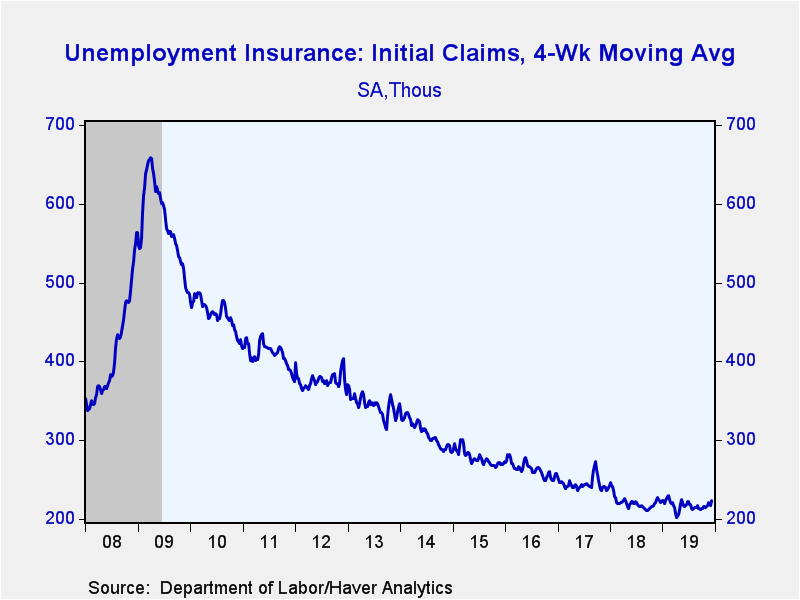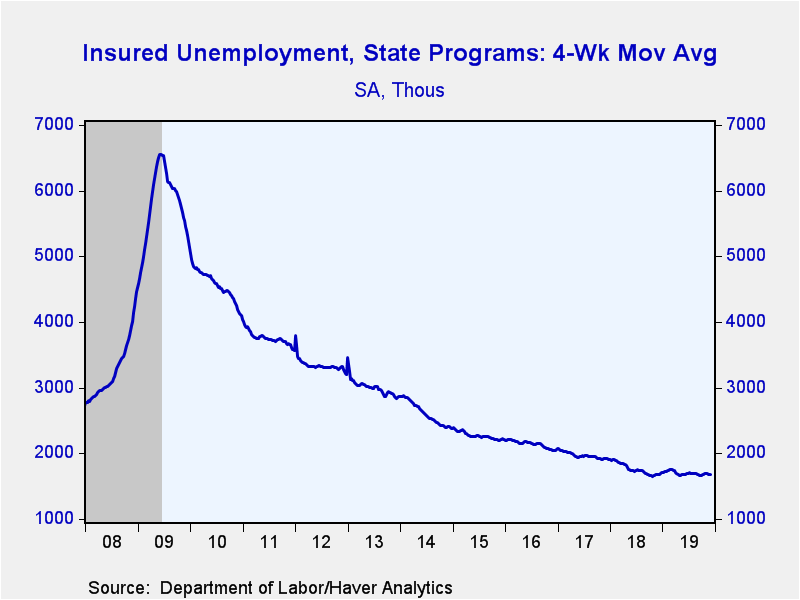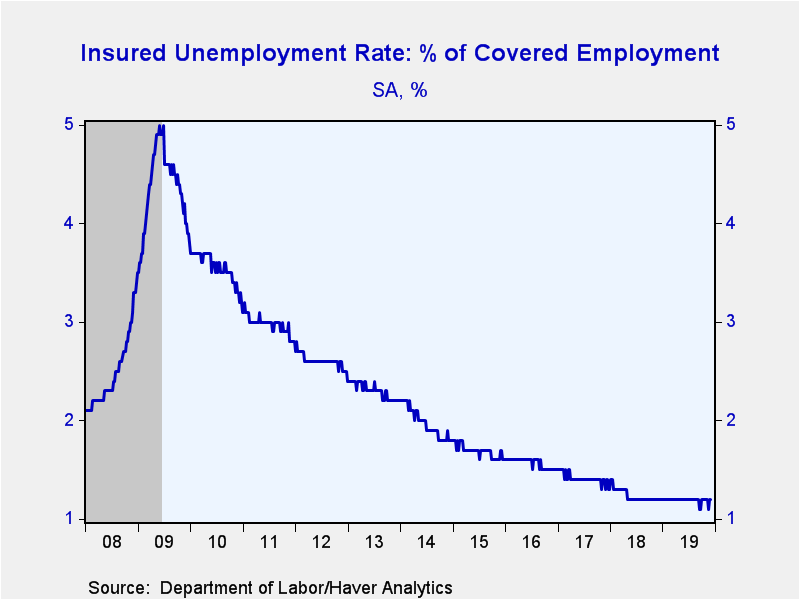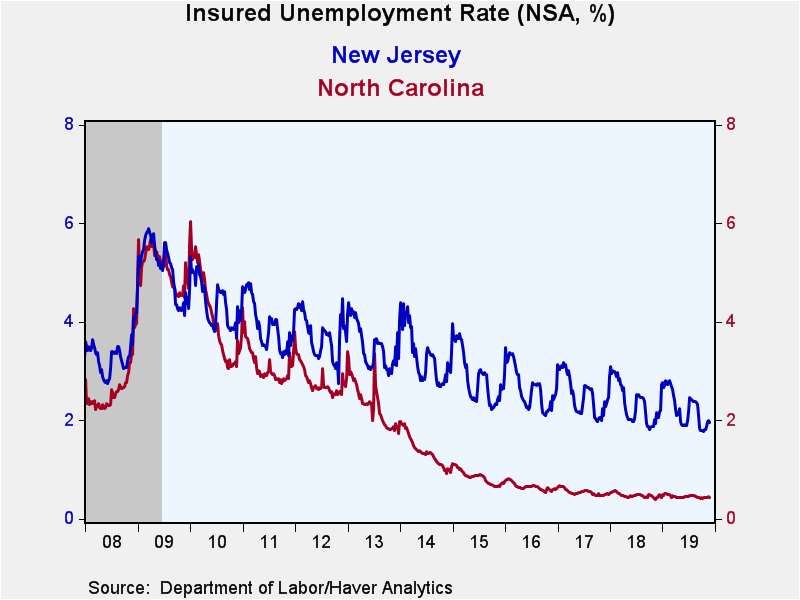 Global| Dec 12 2019
Global| Dec 12 2019U.S. Initial Claims for Unemployment Insurance Jump
by:Sandy Batten
|in:Economy in Brief
Summary
Initial claims for unemployment insurance jumped up 49,000 to 252,000 (+18.3% y/y) in the week ended December 7 from an unrevised 203,000 in the previous week. This was the largest number of new claims since the week ended September [...]
Initial claims for unemployment insurance jumped up 49,000 to 252,000 (+18.3% y/y) in the week ended December 7 from an unrevised 203,000 in the previous week. This was the largest number of new claims since the week ended September 30, 2017. The Action Economics Forecast Survey expected an increase to 213,000 claims. The four-week moving average of initial claims rose to 224,000 from 217,750. A significant part of this week’s jump and the previous week’s decline was likely due to seasonal adjustment. The Thanksgiving holiday this year was the latest it could possibly be while in 2018, it was the earliest. So, this difference likely "confused" the seasonal adjustment factors. The average reading for these two weeks is 227,500, a little elevated but still within the recent range of fluctuations. The last time Thanksgiving was this late (2013), seasonally adjusted claims fell the week of Thanksgiving and surged in the following week, similar to the pattern this year.
Continuing claims for unemployment insurance in the week ended November 30, 2019 fell 31,000 to 1.667 million (unchanged y/y). The November 23 figure was revised up 5,000 to 1.698 million. The four-week moving average of claimants slipped to 1.676 million.
The insured rate of unemployment remained at 1.2% in the week of November 30. In the previous week, it had risen from an all-time low of 1.1%. Data on the insured unemployment rate go back to 1971.
Insured unemployment rates vary widely by state. During the week ending November 23, the lowest rates were in South Dakota (0.34%), Nebraska (0.35%), Florida (0.36%) and North Carolina (0.43%). The highest rates were in Connecticut (1.66%), Pennsylvania (1.66%), West Virginia (1.68%), New Jersey (1.95%), and Alaska (2.67%). Among the other largest states by population not mentioned above the rate was 0.95% in Texas, 1.31% in New York and 1.51% in California. These state data are not seasonally adjusted, thus Alaska has particularly large seasonal swings in insured rates of unemployment.
Data on weekly unemployment claims going back to 1967 are contained in Haver’s WEEKLY database, and they are summarized monthly in USECON. Data for individual states are in REGIONW. The expectations figure is from the Action Economics Forecast Survey, carried in the AS1REPNA database.
| Unemployment Insurance (SA, 000s) | 12/07/19 | 11/30/19 | 11/23/19 | Y/Y % | 2018 | 2017 | 2016 |
|---|---|---|---|---|---|---|---|
| Initial Claims | 252 | 203 | 213 | 18.3 | 220 | 244 | 262 |
| Continuing Claims | -- | 1,667 | 1,698 | 0.0 | 1,756 | 1,961 | 2,135 |
| Insured Unemployment Rate (%) | -- | 1.2 | 1.2 |
1.2 |
1.2 | 1.4 | 1.6 |
Sandy Batten
AuthorMore in Author Profile »Sandy Batten has more than 30 years of experience analyzing industrial economies and financial markets and a wide range of experience across the financial services sector, government, and academia. Before joining Haver Analytics, Sandy was a Vice President and Senior Economist at Citibank; Senior Credit Market Analyst at CDC Investment Management, Managing Director at Bear Stearns, and Executive Director at JPMorgan. In 2008, Sandy was named the most accurate US forecaster by the National Association for Business Economics. He is a member of the New York Forecasters Club, NABE, and the American Economic Association. Prior to his time in the financial services sector, Sandy was a Research Officer at the Federal Reserve Bank of St. Louis, Senior Staff Economist on the President’s Council of Economic Advisors, Deputy Assistant Secretary for Economic Policy at the US Treasury, and Economist at the International Monetary Fund. Sandy has taught economics at St. Louis University, Denison University, and Muskingun College. He has published numerous peer-reviewed articles in a wide range of academic publications. He has a B.A. in economics from the University of Richmond and a M.A. and Ph.D. in economics from The Ohio State University.










